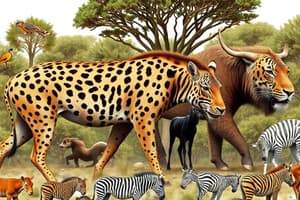Podcast
Questions and Answers
Which of the following is a concept covered in Exam 1?
Which of the following is a concept covered in Exam 1?
- Evaluating the effectiveness of different market research techniques
- Understanding the impact of globalization on international trade (correct)
- Developing strategic marketing plans for new products
- Analyzing the complexities of supply chain management
What is the total number of concepts covered in Exam 1?
What is the total number of concepts covered in Exam 1?
- 50
- 54 (correct)
- 40
- 20
Which of the following concepts is MOST likely NOT covered in Exam 1?
Which of the following concepts is MOST likely NOT covered in Exam 1?
- Analyzing financial statements for investment purposes
- The role of government in regulating international trade
- The impact of technology on global communication
- Developing a successful e-commerce strategy (correct)
Based on the information provided, which of these is NOT a likely concept covered in Exam 1?
Based on the information provided, which of these is NOT a likely concept covered in Exam 1?
Which of the following concepts is likely covered in Exam 1, based on the information provided?
Which of the following concepts is likely covered in Exam 1, based on the information provided?
Flashcards
Exam 1 Concepts
Exam 1 Concepts
A review list of topics covered in Exam 1.
Key Topics
Key Topics
Main subjects that will likely appear on the exam.
Study Strategies
Study Strategies
Effective methods to prepare for Exam 1.
Review Techniques
Review Techniques
Signup and view all the flashcards
Exam Format
Exam Format
Signup and view all the flashcards
Study Notes
Exam 1 Concepts
- Define key terms from Chapters 18-22
- Define evolution and natural selection. Explain their relationship
- Define natural selection and explain the observations that led to the concept
- Explain mechanisms of evolutionary change
- Compare and contrast founder effect and bottleneck effect; how genetic drift causes speciation
- Compare directional, disruptive, and stabilizing selection, giving examples of each
- Identify "more fit" organisms in examples
- Explain the Hardy-Weinberg Principle and how to calculate it
- State the 5 assumptions required for Hardy-Weinberg equilibrium
- Explain case studies supporting natural selection evidence
- Define the biological species concept and compare it to morphological and phylogenetic species concepts; Explain why classifying organisms as species is challenging
- Identify reproductive isolating mechanisms and give examples of allopatric and sympatric speciation
- Interpret phylogenetic trees and identify criteria used to create them. Explain parsimony in phylogenetic tree interpretation
- Define viruses, retroviruses, and bacteriophages
- Explain whether viruses are living or non-living
- Describe viral structures and classifications
- Relate host range and tissue tropism to viruses
- Explain viral replication using lytic and lysogenic cycles
- Discuss the role of viruses in the environment
- Summarize a case study on HIV
Additional Concepts
- Preventative and therapeutic measures for viral infections
- Describe beneficial uses of viruses
- Define prions and viroids from an example
- Explain prehistoric atmospheric conditions and successful organisms
- Describe the 3 domains of life and their characteristics
- Explain the difference between rooted and unrooted phylogenetic trees
- Compare different models of the "tree of life"
- Discuss the role of prokaryotes in everyday life
- Describe methods of studying bacteria
- Identify key characteristics of bacteria based on morphology, cell walls, metabolism, and other requirements
- Discuss the importance and ubiquity of bacteria and archaea; define the differences between bacteria and archaea
- Explain identifying characteristics of bacteria
- Explain why bacteria are ubiquitous
- Discuss the role of prokaryotes in the world , and include bioremediation and ecosystem importance examples
- Explain the differences between Gram + and Gram - bacteria
- Explain the phylogenetic relationships of the three domains
- Discuss why prokaryotes are so successful
- Differentiate between vaccines and antibiotics
- Describe nitrogen fixation, including relevant organisms and results
- Define and describe Eutrophication
- Explain bacterial reproduction methods (transformation, transduction, conjugation)
- Describe metabolic diversity in bacteria
- Detail methods of bacterial identification
Studying That Suits You
Use AI to generate personalized quizzes and flashcards to suit your learning preferences.




